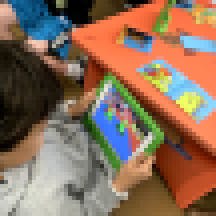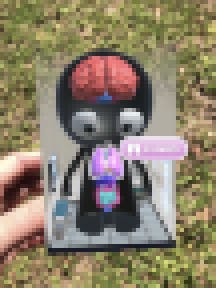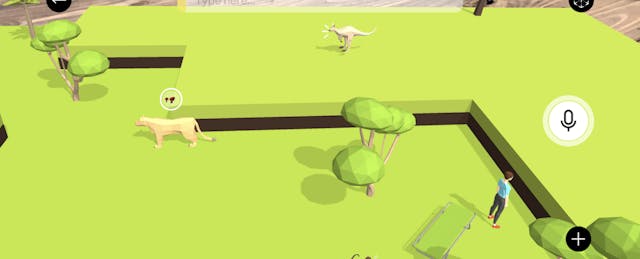Looking back just 5 years ago, there were a limited number of immersive technology tools for the classroom. Most of them were intended for entertainment and only the most eager educators ready to embrace augmented and virtual reality were able to make connections to classroom curriculum. Things have certainly changed.
We now have an enormous library of augmented and virtual reality resources specifically for education and my device is filled with folders and folders of apps, ranging from science to language arts to subjects across the curricular spectrum.
While these tools are becoming more popular and numerous, ones specifically geared toward early elementary students continue to be limited.
As a result, I’ve found educators trying to make existing tools fit. The error I see many beginning to make is forgetting about the diverse needs of our younger students or, worse, pushing tools intended for older students on younger ones. When considering immersive technology resources for our early elementary students, I’ve shared some important, practical areas to keep in mind.
Safety
One of the most alarming concerns I’ve noticed trending this past year is pushing headsets on young children. Some districts are purchasing virtual reality headsets for early elementary students that are specifically labeled for ages 13 and up—think: using the Oculus Go with a kindergarten classroom. Facebook owns Oculus, and just like age restrictions on social media accounts, the devices are intended for students that are old enough for a social media account. Oculus store content is also intended for ages 13-plus. The size of the headsets does not fit well on little heads and often opens the door for dangerous falls or collisions. Some students report feeling sick or nauseous when using any VR headset.
In addition, these headsets sit around our students’ nose, eyes, mouth, ears and are held by their hands. Consider all of these safety concerns when purchasing and implementing virtual reality headsets as these factors can make or break an immersive experience.
Is it possible to have positive experiences for younger students on these devices? Of course! Is the school liable for a possible accident using devices that aren’t intended for these students? Absolutely!
Simple Interface
The tool must be easy enough for teachers to open and give to students to begin learning at this young age. Some teachers may be reluctant to provide multi-step instructions to young students because of the lack of time or added confusion and student frustration. Visual cues and audio support can help students easily navigate through the experience without requesting continued teacher assistance.
Engagement and Interactions
In many ways, immersive technology easily attracts and keeps the interest of our students. While the short term “wow” factor may initially interest kids, that effect is short-lived when students aren’t truly engaged and interacting with the content. This is especially true for our youngest students, whose attention level is much shorter than that of older ones. The best resources provide many interactions—such as games and tasks—which allow students to fully explore the AR or VR experience. With Wonderscope (mentioned below), students need to piece together parts of a plane while exploring a story.
Curriculum
I’ve found many educators excited and eager to use immersive technology in the classroom; however, while they have good intentions, they struggle to find the connection to curriculum or to use the technology effectively. The term “Content is King” is not only accurate but vital to support our classrooms with the resources for the best possible learning experiences. All the resources listed here come with connections to standards and individual lesson plans, which can provide the educator with the ideas, steps and materials to immerse young learners in an experience that targets where students struggle with understanding through traditional methods alone.
The good news is there are exceptional tools that are specific for young learners that can provide the safety, ease of use, engagement and resources for the classroom. Below are a few ideas to get started.

disruptED
One of the most curriculum rich AR/VR resources for early elementary students, these augmented and virtual reality books bring students on a literacy journey as they explore and interact with letters, shapes and opposites. The learner can select either augmented or virtual reality to engage with the books, which include visual and auditory prompts in the directions. Not only are students able to explore and interact with activities, the worksheets and expansive curriculum provide additional resources to help the educator align the experiences with content standards. One of my favorite lessons connects letter recognition with sign language.
The company offers free sample sheets and a full lesson plan to test out the experience with your students.

Mr. Body (now found in the Merge Explorer app)
Finding the right age-appropriate resource to explore the human body can be challenging, especially when the learning is in 3D. The MERGE Mr. Body anatomy experience is perfect for our young students as they rotate the cartoon character while examining and interacting with specific body systems and parts. Using the Merge Cube, a soft block that interacts with augmented reality apps, students can explore and interact with the human body. Students can explain their understanding of the human body by sharing the screen and their voice using the record feature within the app. The stamping feature can get students up and moving around the animated 3D objects and still provide the same interactions without the cube in view.
The new Merge Explorer app offers many other content cards that read content in multiple languages, colors, fonts and sizes using Microsoft’s Immersive Reader integration. (Find a free lesson plan with Mr. Body on the MERGE website.)

MEL Kids by MEL Science
I have recently encountered a product that has entertained my entire family! The MEL kids kit begins with a comic book-style story that thrusts you into a dilemma that must be solved by building a structure. The box includes items to build, and the app shows the visual process in augmented reality. The students complete the build to solve the problem, while completing the learning objective. The next step is exploring the build by seeing it in augmented reality and hearing the information explained at the micro-level.
Students are often captivated with the visuals, maker activities and augmented reality experiences. While the written content will require teacher support, the guided visuals and immersive technology experience support our youngest learners to make powerful connections with the learning objective.

Wonderscope by Within
One of the most engaging storytelling experiences I’ve found for our little ones is the Wonderscope app. The company has found a way to captivate reluctant readers by including them in the story. Students read the prompts as the story progresses and literally wrap the visuals around the reader as each part of the story comes to life. At specific points in the story, students must help the characters by interacting inside the app. Immersive storytelling is growing, and our stories are beginning to place our students in the middle of the plot.
Here are a few more resources to consider when searching for more immersive technology resources:
- Moatboat (pictured at top)
- Catchy Words AR
- Dr. Seuss ABC
- Rox’s Secret Code
The goal of these tools is to empower our young learners with resources to deepen understanding while preparing them for the skills of the future.
We have the opportunity to do much more than entertaining our young learners today. As more augmented and virtual reality resources release, you can continue to inspire a love of learning. Engage your young students in an environment they like to learn in with safe, essential interactions.


